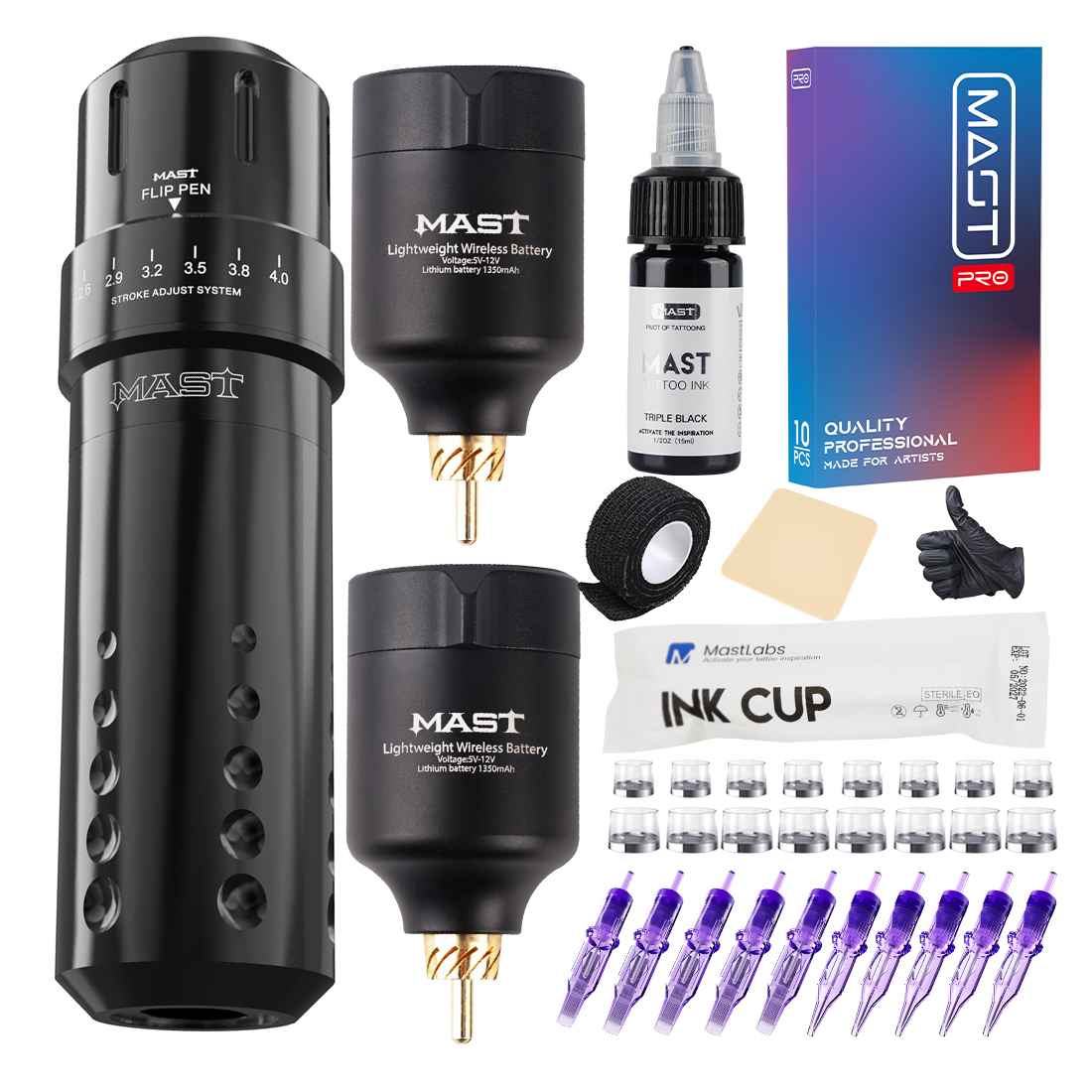Fine line tattoos create intricate designs using extremely narrow lines and delicate detail. Mastering this nuanced tattooing style takes advanced artistic and technical skills.
But with proper training and dedication, aspiring artists can gain mastery in fine line work. Follow this guide to learn how to become a fine line tattoo artist and develop a rewarding career.
What are Fine Line Tattoos?
Fine line tattoos represent a contemporary tattooing style characterized by the use of thin, delicate lines to create intricate designs with precision and detail. This technique contrasts with traditional tattooing, which often features thicker lines.
Fine line tattoos are celebrated for their subtlety and ability to convey intricate designs, intricate shading, and subtle details, making them particularly popular for minimalist and subtle aesthetic preferences.
Artists specializing in fine line tattoos utilize fine needles and precise techniques, resulting in a refined and elegant appearance. Common subjects for fine line tattoos include botanical designs, animals, geometric patterns, and delicate symbols.
The subtle nature of fine line tattoos allows for a more discreet and sophisticated expression of body art, appealing to individuals seeking a blend of artistry and subtlety in their tattoos.
Why Learn Fine Line Tattooing?
Fine line tattooing is an intricate and specialized form of tattoo artistry that involves creating detailed designs with thin and delicate lines.
Learning fine line tattooing can offer various benefits for tattoo artists, enhancing their skills and expanding their artistic repertoire.
Here are several reasons why you might consider delving into the world of fine line tattooing:
Precision and Detailing: Fine line tattooing demands meticulous attention to detail, honing an artist’s ability to work with precision.
It involves creating intricate designs and capturing subtle nuances, fostering an appreciation for meticulous craftsmanship.
Versatility: Fine line techniques can be applied across various styles and genres, from minimalist designs to more complex and elaborate pieces.
This versatility allows artists to cater to a diverse clientele and opens up opportunities for creative expression.
Elevated Aesthetics: Fine line tattoos are renowned for their elegant and sophisticated appearance.
Learning this style enhances an artist’s ability to create visually stunning and refined tattoos that stand out for their subtlety and sophistication.
Adapting to Client Preferences: With the growing popularity of fine line tattoos, artists proficient in this style can meet the evolving preferences of clients who seek detailed, delicate, and less conspicuous designs. This skill set allows artists to cater to a broader spectrum of client demands.
Challenging Artistic Boundaries: Fine line tattooing challenges artists to push their artistic boundaries.
The delicacy and intricacy required demand a high level of skill and creativity, encouraging continuous artistic growth and innovation.
Market Demand: The demand for fine line tattoos has witnessed a notable surge as individuals increasingly appreciate the subtlety and finesse of this style. Learning fine line tattooing positions artists to tap into a market segment that values refined aesthetics.
Professional Development: Adding fine line tattooing to one’s skill set contributes to professional development and distinguishes artists in a competitive industry. It showcases a commitment to mastering various tattooing techniques and staying current with evolving trends.
Also Read: How to Become a Paramedical Tattoo Artist: [The Complete Guide]
What are the differences Between Fine Line Tattooing and Standard Tattooing
Fine line tattooing and standard tattooing represent distinct styles within the realm of body art, each characterized by unique techniques and aesthetic qualities.
Fine Line Tattooing
Thin and Delicate Lines
Fine line tattoos involve the use of thin and delicate lines, often measured in single needle widths. This allows for intricate detailing and precision in the design.
Subtle and Minimalist Aesthetics
Fine line tattoos are known for their subtle and minimalist aesthetics. Artists utilize fine lines to create intricate patterns, detailed designs, and realistic images with a focus on subtlety.
Precision and Attention to Detail
Artists practicing fine line tattooing require a high level of precision and attention to detail. The technique demands a steady hand to create intricate designs without compromising the fineness of the lines.
Suitable for Smaller Tattoos
Due to the intricate nature of fine line tattoos, they are often preferred for smaller, more detailed designs. This style is particularly popular for delicate symbols, intricate patterns, or discreet placement.
Standard Tattooing
Varied Line Thickness
Standard tattooing encompasses a broader range of line thickness, allowing for both bold outlines and finer details within the same design. This versatility makes it suitable for a wide array of tattoo styles.
Diverse Aesthetic Styles
Standard tattooing covers a wide spectrum of aesthetic styles, from traditional and neo-traditional to illustrative and realism. Artists can use a combination of thick and thin lines to achieve different visual effects.
Bold and Vibrant Designs
The use of thicker lines in standard tattooing allows for bold and vibrant designs. This style is often chosen for larger pieces, such as sleeves or back tattoos, where the impact of bolder lines is visually striking.
Quicker Execution
Standard tattooing may generally be executed more quickly than fine line tattooing due to the use of thicker lines and broader strokes. This can be a factor for clients who prioritize efficiency.
Versatility in Cover-ups
The thicker lines of standard tattoos can be advantageous for covering up older tattoos. The bold lines can effectively camouflage or incorporate existing designs into a new piece.
Pros and Cons of Fine Line Tattoos
Fine line tattoos come with their set of pros and cons.
Pros of Fine Line Tattoos
Detailed Artistry
Fine line tattoos allow for intricate detailing, enabling artists to create complex and visually appealing designs with precision.
Subtle and Elegant
The delicate nature of fine line tattoos often results in a subtle and elegant aesthetic, making them a preferred choice for those seeking a more refined appearance.
Versatility
Fine line techniques can be applied across various tattoo styles, offering artists versatility to cater to a wide range of client preferences.
Less Intrusive Healing Process
Fine line tattoos generally involve thinner needles, contributing to a potentially quicker and less intrusive healing process compared to more substantial tattoo styles.
Popular Trend
Fine line tattoos have become a popular trend, making them desirable for individuals who appreciate contemporary and sophisticated body art.
Cons of Fine Line Tattoos
Prone to Fading
Due to their delicate nature, fine line tattoos may be more prone to fading over time, particularly in areas exposed to frequent sunlight or friction.
Time-Consuming
Creating intricate fine line designs can be time-consuming, resulting in longer sessions compared to simpler tattoo styles.
Skill Intensive
Executing fine line tattoos requires a high level of skill and precision. Novice artists may find it challenging to master this technique effectively.
Limitations on Skin Types
Fine line tattoos may not be suitable for all skin types, as they may blur or spread more on skin with certain textures or conditions.
Potentially Higher Cost
Given the skill and time required, fine line tattoos may come with a higher cost compared to simpler tattoo styles.
Also Read: Can You Become Amish If You Have Tattoos? Torn Between Ink and Simplicity
How to Become a Fine Line Tattoo Artist
It’s time to go over the steps you need to become a fine line tattoo artist. Let’s go over them one after the other;
1. Learn Artistic Foundations
Nurture your innate artistic talents through formal training and daily practice. Develop proficiency in diverse mediums like drawing, painting, digital design, etc.
Understanding art principles like composition, balance, perspective, color theory, and negative space inform good tattoo design. Study the works of iconic fine line artists to inspire your style.
2. Master Line Work
Practice making smooth, consistent lines of various weights. Be able to adeptly control line variation, flow, and texture. Line work is the bedrock of fine line tattoos.
Train your hand to evenly apply delicate lines by doing daily line exercises. Start with basic shapes, letters, and symbols. Progress to intricate patterns, animals, landscapes, and anatomy studies.
3. Get Tattoo Equipment For Fine Work
Invest in quality tattoo machines and supplies engineered for the meticulous demands of fine line work. Use lightweight machines with adjustable speed and stroke to dial in your ideal settings.
Choose fine needle groupings like 7-9 round liner needles. Pair this with black inks formulated for crisp precision. Always stick to sterile single-use needles and supplies.
4. Study Advanced Techniques
Learn specialty fine line tattooing methods like single needle work, micro dotting, microblading, and delicate shading gradients.
Watch online tutorials and classes to expand your technical repertoire beyond basic lining. Absorb techniques from experienced fine line artists.
5. Know Skin and Anatomy
Learn skin layers, muscle structure, circulatory system, etc. Understanding physiology and how skin reacts to ink lets you strategically place fine lines for longevity.
Consider how the body’s contours and movement will impact your work. This knowledge prevents prevent blurred or distorted tattoos.
6. Practice on Practice Skin
Buy practice skin samples to hone your technique. Mimic all aspects of real sessions, from setup to breakdown.
Start with the basics then move to more complex designs. Practice skin allows drilling skills without risk until designs are consistently crisp.
7. Complete an Apprenticeship
Find an experienced fine line artist willing to take you on as an apprentice for 6 months to 2 years. Assisting them will build confidence while learning directly from a seasoned mentor.
You’ll gain invaluable insights not taught in books or classes. Be patient and embrace every task to absorb their wisdom.
8. Develop Your Style and Portfolio
As you gain competency, establish your own aesthetic style and area of focus. Document all your original designs and practice tattoos.
Curate selections into a portfolio that captures your talents and visual voice. Let your work speak for itself when applying to shops later.
9. Get Licensed
Complete all state or local requirements to earn your tattoo license. At minimum, this entails a bloodborne pathogen certification course.
Some states mandate apprentice hours or may require passing a test. Get licensed before working independently to ensure you understand safety protocols.
10. Join a Reputable Tattoo Shop
Once licensed, apply to respected shops with a specialty in fine line work. Provide your portfolio showcasing your style.
Explain why you are passionate about fine line tattooing and discuss your long-term goals. Match your vibe and talent to shops suited to nurture your growth.
11. Build Your Clientele
Promote your custom fine line skills on social media and among existing shop clients. Offer free touch ups to demonstrate your dedication to quality results.
Be personable and listen carefully to each client’s vision. Word of mouth about your artistic interpreter skills and professionalism will spread.
12. Continue Advancing Your Skills
Never get complacent. Constantly push yourself to evolve through practice, classes, collaborations, art studies, and conventions. Staying humble, curious, and dedicated to refining your craft is key to long-term success as fine line artist.
Also Read: How to Become a Tattoo Artist in Arizona: [Licensed, Reputable, and Profitable]
Necessary Skills and Abilities Needed to be a Fine Line Tattoo Artist
Becoming a proficient fine line tattoo artist requires a combination of technical skills, artistic abilities, and a keen attention to detail.
Developing these essential skills ensures that an artist can navigate the intricacies of creating detailed and delicate designs characteristic of fine line tattooing.
Here are key skills and abilities needed to excel in this specialized field:
Precision Drawing Skills
Fine line tattoos demand precise and accurate drawing skills. Artists must be adept at creating intricate designs on paper before translating them onto the skin, emphasizing the importance of precision in their craft.
Controlled Hand Movement
Fine line work requires a steady hand and controlled movements. Artists must develop the ability to maintain consistent pressure and control when working with thin needles to ensure clean and even lines.
Understanding Needle Techniques
Mastery of needle techniques is crucial in fine line tattooing. Artists need to be proficient in various needle configurations, understand their impact on line thickness, and employ techniques such as single needle and multiple needle grouping for different effects.
Patience and Attention to Detail
Patience is a virtue in fine line tattooing. Artists must pay meticulous attention to every detail, no matter how small, to ensure the precision and clarity of the design. Taking the time to perfect each element contributes to the overall quality of the tattoo.
Knowledge of Skin Anatomy
Understanding the intricacies of skin anatomy is essential for fine line tattoo artists. This knowledge helps in adapting techniques to different skin types and ensures that the tattoo heals properly, maintaining the integrity of the fine lines.
Color Theory and Shading Techniques
While fine line tattoos are often monochromatic, a solid understanding of color theory and shading techniques is crucial. Artists should be capable of creating subtle gradients and shading effects to add depth and dimension to their designs.
Adaptability and Innovation
Fine line tattoo artists often work on diverse projects, requiring adaptability and innovation. Being able to tailor their skills to different styles and trends ensures versatility and relevance in the ever-evolving tattoo industry.
Continuous Learning and Professional Development
Fine line tattooing is a dynamic field, and artists must commit to continuous learning and professional development. Staying updated on industry trends, attending workshops, and seeking mentorship contribute to ongoing skill enhancement.
Effective Communication with Clients
Clear communication with clients is paramount. Fine line artists should be skilled in translating clients’ ideas into feasible designs, managing expectations, and providing guidance on the tattooing process.
By focusing on developing these skills and abilities, you as an aspiring fine line tattoo artists can lay the foundation for a successful career.
Developing a Fine Line Tattoo Portfolio
Developing a Fine Line Tattoo Portfolio involves a strategic approach to showcase an artist’s proficiency in creating detailed and intricate designs.
Consider the following when developing a Fine Line Tattoo Portfolio:
- Emphasize detail
- Showcase minimalist aesthetics
- Use negative space
- Be consistent in line thickness
- Showcase variability
- Pay attention to skin tone
- Incorporate fine line with other styles
- Use photography and proper presentation
- Collaborate with our clients
- Keep evolving your Style
Common Fine Line Tattoo Motifs, Themes and Placements
When delving into the realm of fine line tattoos, you’ll discover a plethora of motifs, themes, and placement options that contribute to the delicate and intricate nature of this art form.
Understanding common elements in fine line tattooing can guide your choices, ensuring a harmonious blend of precision and aesthetic appeal.
Common Fine Line Tattoo Motifs
Botanicals
Delicate flowers, leaves, and branches showcase the finesse of fine line work. Roses, cherry blossoms, and ferns are popular choices, allowing for detailed renditions with thin, elegant lines.
Animals
Fine line techniques beautifully capture the essence of animals. Intricately designed pets, birds, or sea creatures can become stunning, lifelike tattoos with subtle linework.
Geometric Patterns
Geometric shapes and patterns, such as mandalas or minimalist line art, are frequently explored in fine line tattooing. The precision required for these designs enhances their visual impact.
Insects
Butterflies, dragonflies, or bees rendered with fine lines create ethereal and visually captivating tattoos. The intricate details of insect anatomy can be beautifully highlighted through this technique.
Celestial Elements
Fine line tattoos often feature celestial motifs like stars, moons, and constellations. These designs lend themselves well to subtle, celestial elegance.
Common Fine Line Tattoo Themes
Minimalism
Fine line tattoos excel in minimalistic themes. Simplified designs, single-line drawings, and negative space utilization contribute to an understated yet impactful aesthetic.
Nature Scenes
Fine line tattoos depicting serene landscapes, seascapes, or mountain ranges are popular themes. These designs evoke a sense of tranquility through detailed, fine linework.
Portraits
Fine line techniques are often employed in portraiture. Whether it’s a loved one’s face or a beloved pet, the precision of fine lines adds a touch of sophistication to these deeply personal tattoos.
Abstract Concepts
Abstract concepts and symbols find expression through fine line tattoos. Whether it’s representing emotions, philosophies, or life events, this style allows for nuanced storytelling.
Also Read: How to Become a Tattoo Artist in Utah – Licensure, Training and Running a Tattoo Shop
Common Fine Line Tattoo Placements
Wrist
Fine line tattoos on the wrist are popular for their subtlety. Delicate symbols or small motifs can accentuate this area gracefully.
Collarbone
Fine line designs along the collarbone create an elegant and eye-catching visual. Intricate patterns or minimalist symbols work well in this placement.
Ankle
Ankle tattoos benefit from fine line precision. Whether it’s a botanical motif or a discreet symbol, this placement allows for subtle yet impactful artwork.
Inner Arm
The inner arm provides a canvas for more extensive fine line work, such as elongated designs or text. This placement allows for a blend of subtlety and sophistication.
Conclusion
We’ve talked about how to become a fine line tattoo artist in this article. Achieving mastery as a fine line tattoo artist requires immense patience, discipline, and devotion to the art form.
But artists who meticulously build their skills will be richly rewarded with a career doing nuanced, meaningful work. By following these steps, a passion for fine line tattoos can become a lifelong and deeply fulfilling calling.
FAQ on How to Become a Fine Line Tattoo Artist
How long does it take to become proficient at fine line tattooing?
It takes most artists 3-5 years of intensive practice to build advanced fine line skills. However, some innately gifted artists with extensive art backgrounds can progress faster through their apprenticeship. Budget 2-4 years before working independently.
What kind of earnings can fine line artists make?
It varies based on reputation, shop quality, and location. However, specialty fine line artists can typically earn $150-$250 per hour. Their expertise at advanced techniques makes them highly sought after.
Do I need artistic experience to become a fine line artist?
Yes, extensive drawing and design experience is a must. Tattooing is an art form. Innate artistic talents and sensibilities are mandatory foundation before the technical tattoo skills can be developed. Fine lines require profound creative vision.
How do I choose a mentor for a fine line apprenticeship?
Find well-respected artists skilled specifically in fine line tattooing. Do not just apprentice under whoever is convenient. You want someone fully proficient in the niche style you want to specialize in. Choose based on their portfolio and mastery.
Should I learn other styles before specializing in fine line tattoos?
Yes, starting with a well-rounded apprenticeship provides core competencies applicable to fine line work later. After learning fundamentals, you can then seek specialized fine line mentoring. But basic experience gives context that boosts those advanced skills.
Should I learn fine line tattooing as a beginner artist?
No, fine line requires mastery of core tattoo skills first. Wait until proficient in standard lining, shading and coloring before specializing.
Do fine line tattoos hurt more?
The sensation differs from regular tattooing but is not necessarily more painful overall. The light scratching feels less invasive than sustained buzzing.
How long does fine line tattoo numbing effect last?
1-3 hours typically. Break longer sessions into multiple appointments. Numbing makes maintaining precision difficult so use minimally.
Should I avoid coffee before fine line tattooing?
Yes, limit caffeine and other stimulants that can induce hand shaking or restless leg. Focus and stillness is vital.
Do fine line tattoos need touch-ups more often?
Yes, the thinner lines often require more touch-ups as they blur slightly over time. But skilled application minimizes frequency.
Can you make a fine line tattoo thicker later?
Yes, skilled artists can go back and carefully reinforce fine lines with slightly thicker linework if diffusion occurs and boldening is desired.
Does fine line tattoo skill translate to regular tattooing?
Mastery of fine lines greatly improves overall tattoo line work precision, but practice is still needed to apply broader techniques well.
Should I tip fine line artists more?
Yes, it’s customary to tip fine line artists up to 30% in recognition of their greater skill specialization and effort needed.
Can fine line tattoos be removed more easily?
Slightly – the thinner ink lines break up faster under laser – but overall tattoo removal still requires multiple treatments.






